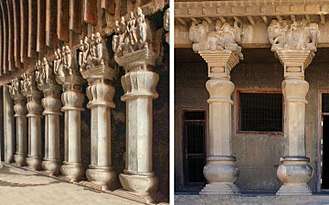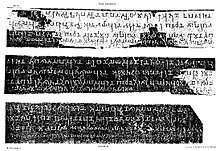Rishabhadatta

Rishabhadatta (also Ushavadata) was viceroy of the Western Satrap ruler Nahapana, and his son-in-law.
Ancient inscriptions were incised in the Pandavleni caves near Nasik describing how Rishabhadatta was son of Dinika and had married Dakshamitra, daughter of Nahapana. According to the inscriptions, Ushavadata accomplished various charities and conquests on behalf of his father-in-law. He constructed rest-houses, gardens and tanks at Bharukachchha (Broach), Dashapura (Mandasor in Malva), Govardhana (near Nasik) and Shorparaga (Sopara in the Thana district).
He also campaigned in the north under the orders of Nahapana to rescue the Uttamabhadras who had been attacked by the Malayas (Malavas).[1]
He excavated a cave (one of Nasik Caves) in the Trirashmi hill near Nasik and offered it to the Buddhist monks:[2]
"Success ! In the year 42, in the month Vesakha, Ushavadata, son of Dinika, son-in- law of king Nahapana, the Kshaharata Kshatrapa, has bestowed this cave on the Samgha generally...."
— Inscription No.12 of Nahapana, Cave No.10, Nasik[3]
| Nasik Pandavleni Caves, cave No.10 | |
| |
Ushavadata also presents himself as a Saka in inscription 14a:

"[Success !] By permanent charities of Ushavadata, the Saka, [son of Dinika], son-in-law of king Nahapana, the [Kshahara]ta Kshatrapa...."
— Inscription No.14a of Nahapana, Cave No.10, Nasik[4]
In his reign, he is also said to have converted to Hinduism.[5]
The Satavahana king Gautamiputra Satakarni appears to have defeated Rishabhadatta. An inscription discovered in Nashik, dated to the 18th year of Gautamiputra's reign, states that he donated a piece of land to Buddhist monks; this land was earlier in the possession of Ushavadata.[6]
See also
Notes
References
- Divatia, N. B. (1993). Gujarati Language and Literature. Asian Educational Services. ISBN 81-206-0648-5.
- Singh, Upinder (2008). A History of Ancient and Early Medieval India: From the Stone Age to the 12th Century. Pearson Education India. ISBN 978-81-317-1120-0.
.jpg)
.jpg)
.jpg)
.jpg)
.jpg)